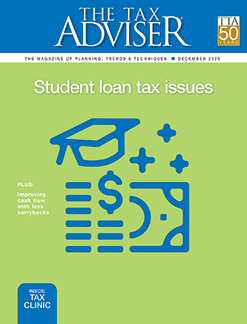- column
- From the Tax Adviser
Going virtual with client communications
Please note: This item is from our archives and was published in 2020. It is provided for historical reference. The content may be out of date and links may no longer function.
Related
Inflation adjustments to retirement account limits issued for 2026
Almost 1,400 IRS employees receive layoff notices, adding to staff losses
IRS ends Direct File, shifts focus to Free File upgrades and private sector

Earlier this year, many firms faced the major challenge of being unable to receive information from clients during the stay-at-home or shelter-in-place orders that were in effect throughout the country. It became extremely difficult to share information with clients via the normal pickup and drop-off procedures that many clients had become familiar with. This lack of access caused many firms to look closely at electronic or online organizers and portals to collect data from clients for preparing tax returns.
Clients historically have used tax organizers to help gather their tax paperwork and remind them of the items that they may be missing from the prior year. An electronic organizer is no different. A practice should adopt an electronic organizer system that is interactive and allows clients to upload tax documents directly into the organizer platform. In most cases, the platform is accessible by both the tax professional and the client. This means the tax professional (or possibly an administrative support person) can check the status of the documentation to determine when there is enough information in the file to get started on the tax return.
Transitioning to an online or electronic organizer system poses challenges for both clients and firms. Clients will likely need direction on how to upload the data or how to link bank accounts or broker accounts to the online organizer system. They may not have easy access to digital information or the ability to provide it. In addition, clients may not be comfortable putting their information online. Tax professionals will have to spend time educating clients on the new process and be able to discuss the security protocols that are put in place to protect their data. Firms will have to review intake policies and procedures and adapt them to account for this new mechanism of collecting information. This will be a different process for many firms and clients, and there may be bumps in the road. But this year has provided many opportunities to deal with challenges, and gathering information electronically is likely to provide many efficiencies.
CLIENT MEETINGS/INTERACTIONS
As with the challenge of collecting data, office closures and social-distancing requirements severely limited the ability to meet with clients in person. In a virtual practice, it goes without saying that virtual meetings are a must. The good news is that there is no shortage of virtual meeting platforms. However, the real challenge is how to effectively conduct a client meeting via an online virtual meeting platform.
Review the various virtual conference platforms and determine which tool meets your needs. Factors to consider include: (1) ease of access (readily available with no cost to the client); (2) the ability to share screens (to be able to walk through materials, etc.); (3) the ability to record the call (if you will want to maintain a record of the conversation for later reference, but be sure you consider whether you need to obtain the participants’ permission); (4) time limits; and (5) security.
Having a virtual practice should not limit the face-to-face interaction that clients want and need. The ability to meet in a virtual space has never been easier.
For a detailed discussion of the issues in this area, see “Tax Practice Management: Modernize and Virtualize Your Tax Practice: Part 1,” in the December 2020 issue of The Tax Adviser.
— Brandon Lagarde, CPA, J.D., LL.M., and J. Raleigh Cutrer, CPA/PFS/ABV
The Tax Adviser is the AICPA’s monthly journal of tax planning, trends, and techniques.
Also in the December issue:
- An examination of tax issues surrounding student loans.
- A look at improving cash flow with loss carrybacks.
- A discussion of tax planning strategies for cryptocurrency.
AICPA members can subscribe to The Tax Adviser for a discounted price of $85 per year. Tax Section membership includes a one-year subscription to The Tax Adviser.


















